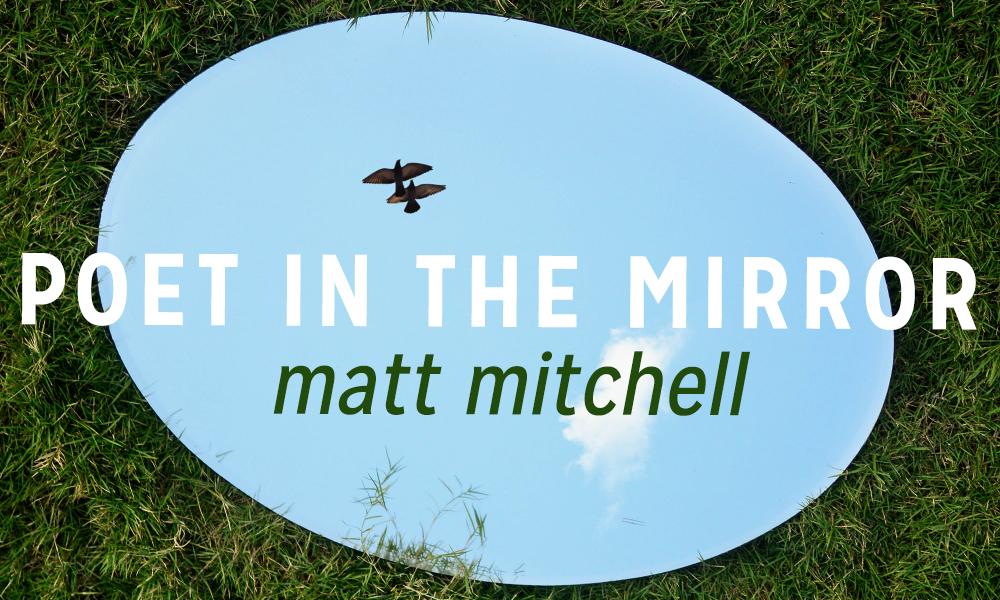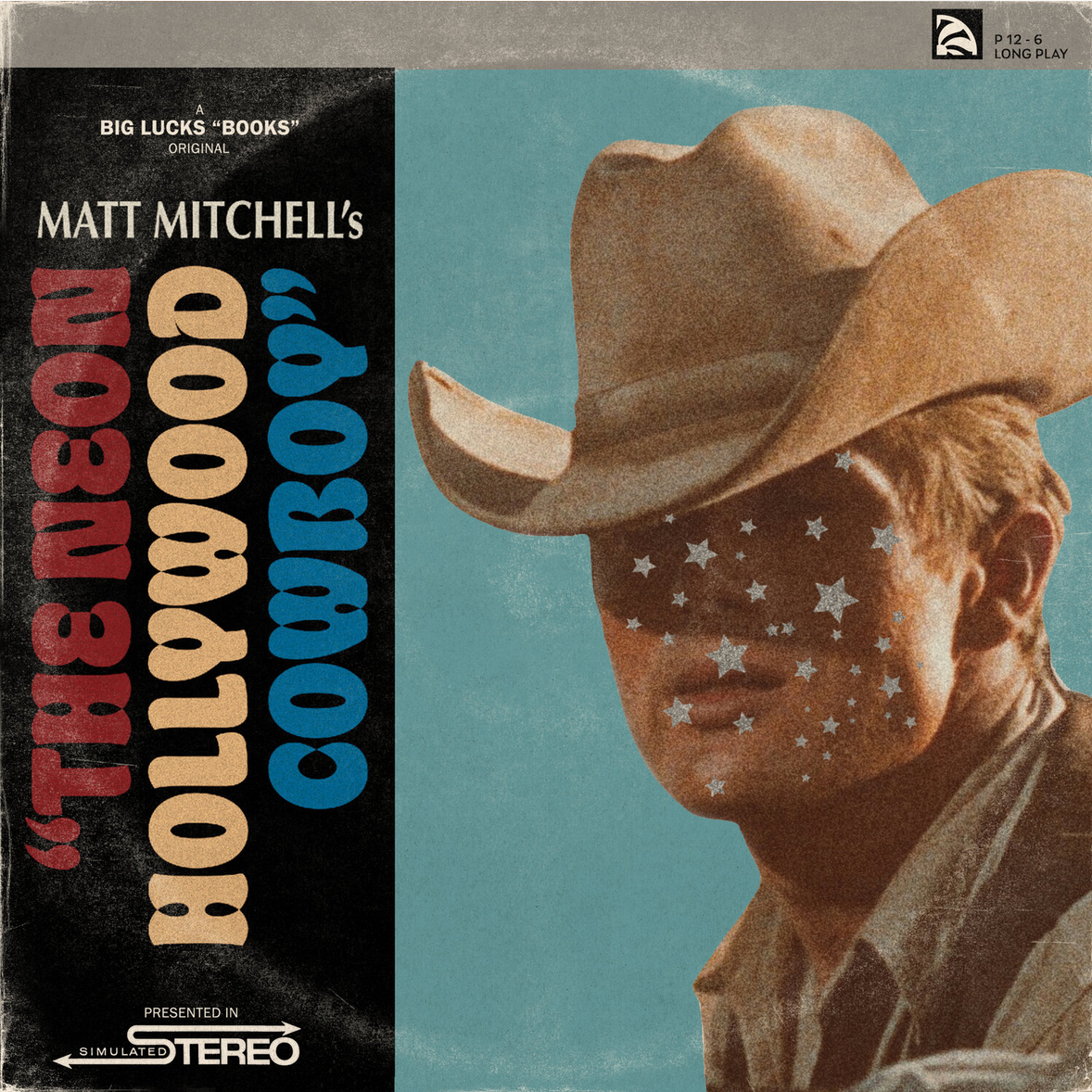Poet in the Mirror: Matt Mitchell

We’re so proud to share some insight into the lives and hearts of today’s poets with our Poet In The Mirror series. This week, Matt Mitchell—author of The Neon Hollywood Cowboy (from Big Lucks)—shares insight into writing about identity, popular culture in poetry, and how to stay true to your independent vision when publishing a collection.
On Identity
This book begins with a birth. Specifically, it opens with the poem “The Birth of the Neon Hollywood Cowboy,” where the speaker asserts: “Intersex people / are the best cowboys.” As a young poet yourself, what advice would you give to other young poets who are grappling with writing about identity?
Take your time. Folks try to suppress or question the validity of who you are if you’re not explicitly writing about it. Kaveh Akbar once told me that, if you are writing a poem, no matter the subject, then that poem is a product of who you are. I am intersex and my love poems and my sports poems are intersex poems. Even if the poems aren’t explicitly intersex, they are inherently so. I spent a long time writing poems about my grandparents before I became comfortable enough to really lean into the real electricity of who I actually am. So I hope other young poets take as much time as they need to become vulnerable in their writing. They may never get there, and that’s okay, too. The writing is still tethered to their identity, whether we know what that is or not. The god complex of westernized publishing makes us think putting work out into the world has a time limit. But truthfully we have all the time in the world, and it’s such a gift to go at your own pace.
On When to Publish
The speaker in this book claims “intersex kids are the new doorway of language.” When did poetry become a vehicle into exploring intersex identity for you? When did you decide to pursue that as a professional endeavor, and try to publish this book?
As soon as I had no one else to talk about it with. I now know a few other intersex folks who know they’re intersex. They make me feel alive. The internet helped connect me with them. But when I was 20 I left therapy and, shortly after, got the official news about being intersex. I didn’t know anyone else like me then. And I was too afraid to go back to therapy, so I wrote this book instead. But now that the book is finished, I’m going to therapy again. I’m meeting new people, virtually and from afar, as who I really am, and I’m learning to love them authentically. My therapist hasn’t had a syringe cap break in their skin but professionally knows how to help me manage the repercussions of when a syringe cap breaks in my own. I’m still writing about being intersex, but it’s in accordance with this new chapter of my life. And it’s such a personal relief to not lean so hard into a book for my own closure. The poems I’m writing now are coming from a place of joy and pride, not from a place of necessity.
On Changing the Conversation
One of my favorite moments in the book is when the speaker says “if i have a child, it will be to create / more intersex children. // because doctors are slowly eradicating us / after birth.” Thinking of this book as a creation, as representation for intersex people, what was the most surprising thing about ushering this collection into the world?
Honestly, it’s been seeing how some folks tiptoe around the word intersex when they’re talking to me about the book. It’s an identity so vastly underrepresented in poetry, and in media at large, at least in a non-comical sense, that no one knows what to do with it yet. Folks still think the episode of Friends where Ross helped spread a rumour about Rachel being a hermaphrodite is a comedic breadwinner. I think we’re sometimes too afraid of making a mistake and saying the wrong thing, so we end up not saying much at all. Whenever that happens, I’m momentarily convinced the world isn’t quite ready for all this intersex talk. But I hope this book is a good first step in pivoting the conversation away from I don’t understand how you exist, so how am I supposed to hold you and pushing it towards you have held me for so long, how can I hold you up, too.
On the Reader
The Neon Hollywood Cowboy (the book and the speaker) often relies on popular culture references. Some new, and some of generations past. Some that can be looked up, and some that rely on cultural understanding, like Tyler the Creator’s relationship to queerness or Mitski’s Twitter. What would you say are the benefits or drawbacks of such references? Is there ever a fear that a poem will be lost if its reader doesn’t understand the references?
A undergrad professor of mine, Mary Quade, once told me it is not the writer’s job to always explain a reference, but instead it’s the reader’s job to be curious enough to investigate further into something they aren’t familiar with. I carry that with me, even today. I think readers who love poetry will find non-referential things in my poems to hold onto. But the references, they’re for me and they’re for readers like my folks, who love me dearly but don’t always get poetry. My best friend Alex, he loves the Tyler, the Creator poem—not because he’s in it, but because the words are familiar enough for him to love it. He doesn’t regularly read poetry, but I find myself always trying to write towards him. He is the embodiment of an audience I am trying to adopt with my work: the non-poetry people who have a preconception of poetry as all Whitman captains and tigers spelled wrong. Sure, the way trees talk is poetry. The shape of the moon is poetry. But a hot dog is also poetry. LeBron James’ tomahawk dunk over Kevin Garnett in the 2008 NBA Playoffs is poetry. That one pothole I always fail to miss on Parkman Road is poetry, too.
That is all to say: every reference in The Neon Hollywood Cowboy is intentional and meant for somebody, and whatever else is in-between is also meant for someone. I’m not worried about what I did on purpose so much as I’m perpetually scared to death about what I didn’t do.
On Craft
This book is full of after poems, seems aware of itself as poetry, and even contains a co-written poem. What I mean to say is: the love for the craft is so clear throughout this collection. What is one piece of craft advice that motivated you throughout the writing of this book?
There were multiple instances where I was working on parts of this book with Hanif Abdurraqib, and he would read through certain prose poems and deadass say to me “I’m wondering if this [poem] is an essay.” And that’s why there were once poems in this manuscript that are not in the final cut everyone will read. Sometimes we all have to step back, look at our prose poems, and be painfully honest with ourselves about whether they are just lyric essays posing as poems.
On Advice for Emerging Poets
What do you wish you knew between your book’s first and final drafts? What advice would you give to emerging poets who are yet to publish their first book?
The first dozen or so drafts of The Neon Hollywood Cowboy very much catered to traditional publishing standards. It had a more romantic-sounding title. I layered it with what I thought presses wanted. But when I came out as intersex and started writing a book of poems accordingly, I knew it was going to be hard selling something like that to a press like Graywolf or Copper Canyon. I feared I would have to settle. I feared I would have to first etch my name in poetry on the basis of tradition rather than uniqueness. But when I pitched the book to Mark Cugini at Big Lucks, they were down for it immediately, and I realized that you can still hold onto your independence in publishing. You just have to remind yourself that your identity is not way out of left-field to everyone. I hope emerging poets never give up their creative autonomy. There’s a press out there that will be floored to publish your absurd little book. And you should never stop looking for them until you find them.
 Matt Mitchell‘s 10th cousin was Princess Diana. He’s honky tonk electric and covered in denim. He wrote The Neon Hollywood Cowboy (Big Lucks, 2021). Find him somewhere in Ohio and also on Twitter @matt_mitchell48.
Matt Mitchell‘s 10th cousin was Princess Diana. He’s honky tonk electric and covered in denim. He wrote The Neon Hollywood Cowboy (Big Lucks, 2021). Find him somewhere in Ohio and also on Twitter @matt_mitchell48.
Saba Keramati
Saba Keramati is a Chinese-Iranian writer from the San Francisco Bay Area. A graduate of University of Michigan and UC Davis, her work has been nominated for a Pushcart Prize, and appears or is forthcoming in Michigan Quarterly Review, Glass: A Journal of Poetry, Vagabond City Lit, and other publications. You can follow her on Twitter @sabzi_k.